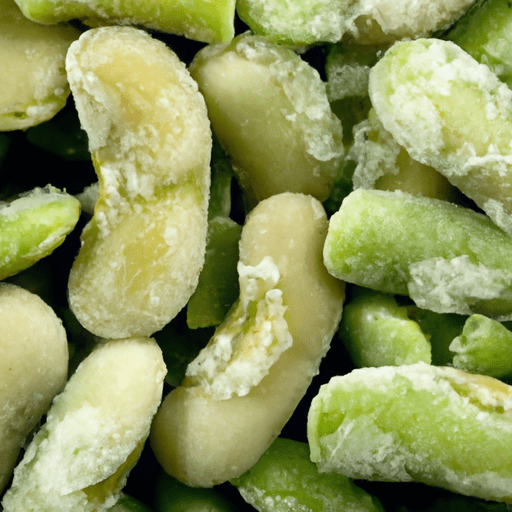Frozen Baby Lima Beans: A Delightful Addition to Your Culinary Repertoire
If you’re looking to add a burst of flavor and nutritional value to your meals, look no further than frozen baby lima beans. These petite, vibrant green legumes deserve a spot in your culinary repertoire. In this article, we’ll delve into the taste, common uses, nutritional benefits, and share some interesting history and facts about frozen baby lima beans.
Taste and Texture
Frozen baby lima beans have a delicate and slightly buttery flavor that is often described as nutty and mildly sweet. Their tender yet firm texture adds a pleasant bite to dishes, making them versatile and adaptable to various cooking methods. These beans are loved for their ability to soak up flavors, making them perfect for absorbing the aromas of spices and seasonings.
Common Uses in Cooking
The culinary possibilities with frozen baby lima beans are vast. They can be incorporated into a wide range of dishes, from soups and stews to salads and side dishes. Here are a few popular methods for showcasing the delectable potential of frozen baby lima beans:
Soups and Stews
Frozen baby lima beans bring heartiness and substance to soups and stews. Their creamy texture and rich flavor contribute depth to broths, creating a comforting and satisfying dish. Adding these beans to classics like minestrone, vegetable soup, or even chili can elevate the overall taste and nutritional profile.
Salads
When blanched or lightly sautéed, frozen baby lima beans become vibrant and refreshing additions to salads. Tossed with crisp greens, cherry tomatoes, feta cheese, and a tangy vinaigrette, they add a delightful element of color, texture, and flavor. Alternatively, mixed into grain-based salads or combined with other legumes, they offer a substantial yet nutritious element.
Side Dishes
Frozen baby lima beans make for an excellent side dish, whether served on their own or accompanied by other vegetables or proteins. Prepared with a touch of garlic, herbs, and a drizzle of olive oil, they can complement grilled meats, roasted poultry, or fish. Alternatively, when cooked with onion, bacon, and a hint of maple syrup, they transform into a sweet and smoky delight.
Nutritional Benefits
Frozen baby lima beans come packed with essential nutrients that contribute to a healthy diet. They are an excellent source of fiber, protein, and complex carbohydrates. Additionally, they provide significant amounts of vitamins and minerals, including folate, iron, potassium, and magnesium. Incorporating these beans into your meals can help promote digestive health, support muscle function, and contribute to overall well-being.
History and Fun Facts
Lima beans, also known as butter beans, have a rich history dating back thousands of years. Native to South America, they were cultivated by ancient civilizations, including the Incas and the Mayans. They were introduced to Europe and the rest of the world during the period of exploration. Lima beans got their name from the city of Lima in Peru, which played a crucial role in their distribution.
Interestingly, frozen baby lima beans gained popularity in the United States during the early 1900s when frozen food preservation methods were developed. This innovation allowed people to enjoy the flavors and nutritional benefits of these beans year-round.
Conclusion
From their delicate taste and versatility to their nutritional benefits and fascinating history, frozen baby lima beans have rightfully earned their place in the culinary realm. Whether you incorporate them into soups, salads, or side dishes, these petite legumes are sure to add a burst of flavor and elevate your cooking endeavors. So why not give frozen baby lima beans a try and explore the myriad of possibilities they bring to your table?
Frozen Baby Lima Beans
Origin: Baby lima beans are believed to have originated in South America, particularly in Peru, where they have been cultivated for thousands of years. They were first introduced to America in the 19th century.
Common Uses: Frozen baby lima beans are a versatile ingredient and can be used in various dishes. They are commonly added to soups, stews, and casseroles. These beans can also be sautéed, roasted, or pureed to make dips or spreads. They have a creamy texture and a subtle, nutty flavor.
Nutritional Benefits: Frozen baby lima beans are nutrient-dense and offer several health benefits. They are an excellent source of dietary fiber, which helps aid digestion and promote a feeling of fullness. These beans are also rich in protein, providing essential amino acids necessary for growth and repair. Additionally, they are a good source of folate, iron, potassium, and magnesium.
Unique Properties: Baby lima beans are known for their small size and tender texture. They have a pale green color and a delicate, buttery flavor. Unlike mature lima beans, which have a mealy consistency, baby lima beans maintain their shape and firmness after cooking, making them suitable for a variety of preparations.
Historical Significance: Lima beans have a long history in indigenous South American cuisine, dating back to ancient times. They were highly valued by the Incas and Mayans, who cultivated and consumed various types of lima beans. Over time, these beans spread to other parts of the world through trade and exploration. Today, frozen baby lima beans are widely enjoyed as a nutritious and flavorful ingredient in many cuisines around the globe.




Use the share button below if you liked it.
It makes me smile, when I see it.